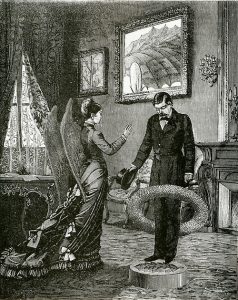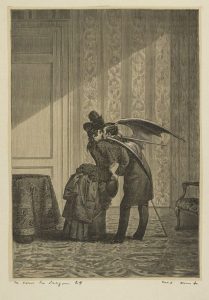Ernst’s Tuesday chapter of Une semaine de bonté focuses loosely on the element of fire through imagery of dragons, but at root it is a commentary upon his society’s understanding of romance and sexuality. Figures in the collages are increasingly divorced from humanity by the growing presence of various beastly body parts: heads, wings, tails, and more. Ernst’s animalization of the female figures in his collages struck me as a commentary upon female sexuality. As society began to break out of the constraints of the Victorian era, women found themselves in a ‘liberated’ position in comparison to the past. This moderate degree of sexual freedom posed a fierce threat to Victorian masculinity. Throughout Une semaine de bonté,Ernst espouses this fear of compromised masculinity and attempts to compensate for it by animalizing the women in his collages. The “privilege” of the male gaze becomes an assumption, the objectification of women: a natural way to view the opposite sex. Collage works to the artist’s advantage, for he often cuts out human heads to replace them with animal ones, while retaining the most sensual parts of the female body. This follows an understanding of the woman as “Other:” an exotic entity who perhaps required objectification to be understood. Just as white males would do with people of other races, women were quite easy to exoticize and eroticize. Ernst’s collages in the Tuesday chapter are a hyperbolic expression of this perspective. He seems to see mere bodies instead of women, strange, static spectacles instead of living, thinking entities. Yet in these heavy-handed examples of objectification, is Ernst accidentally highlighting the power of women in his society? To reframe it with a question posed in class: Are men “trapped” by women and their beauty?

Images With(In) Books

